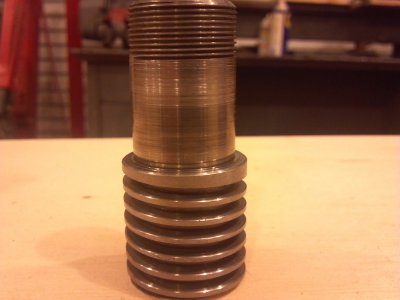- Joined
- Oct 7, 2013
- Messages
- 305
Ok, to put things in the proper perspective right off, yes, I'm a rank neophyte, have no idea what the heck I'm doing...yet. Anyway...
I'm working on bringing a Delta Rockwell 11 (my first lathe) back to usable condition. I wouldn't call it a restoration, from a purists point of view, but I'm trying to repair/replace everything that needs it.
Below is a picture of the worm. The threads look good, at least to me, just by eyeball, but the bearing surface is rough. I measured it at 1.121-1.123. at various places. The major diameter of the threads is about 1.119. I'm thinking that I could take a skim off the bearing surface and smooth it up and take up the difference in the bushing when I replace it. Or, should I just not worry about it? It occurs to me that it is not a bearing surface that runs with any speed and doesn't take a lot of stress. I'm thinking that if I just replaced the bushing, I might not ever wear it out in my lifetime. What would you do?
Advice and thoughts would from experience would be appreciated.

Tony

I'm working on bringing a Delta Rockwell 11 (my first lathe) back to usable condition. I wouldn't call it a restoration, from a purists point of view, but I'm trying to repair/replace everything that needs it.
Below is a picture of the worm. The threads look good, at least to me, just by eyeball, but the bearing surface is rough. I measured it at 1.121-1.123. at various places. The major diameter of the threads is about 1.119. I'm thinking that I could take a skim off the bearing surface and smooth it up and take up the difference in the bushing when I replace it. Or, should I just not worry about it? It occurs to me that it is not a bearing surface that runs with any speed and doesn't take a lot of stress. I'm thinking that if I just replaced the bushing, I might not ever wear it out in my lifetime. What would you do?
Advice and thoughts would from experience would be appreciated.

Tony


